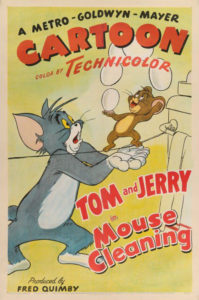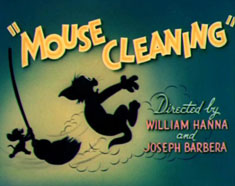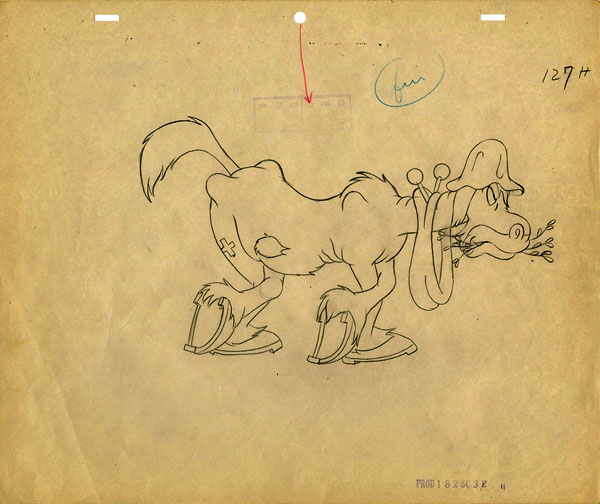
We’ve saved the best for last with one final Tom and Jerry animator breakdown!
By the time Mouse Cleaning was in production, Irv Spence and Ray Patterson had returned to MGM. Hanna-Barbera’s crew of animators was solidified, and its four key animators (including Ken Muse and Ed Barge) remained with the series into the mid-1950s. In several entries, Tom’s owner (unofficially named in the cartoons, but often known as “Mammy Two-Shoes”) chastises him for his mistakes and threatens his ejection from the house if he doesn’t straighten up. In this standout entry, Tom tracks mud in the house and forced to mop the floor himself. His owner leaves the house for grocery shopping and warns him to keep the house clean if he wants to keep his place. Jerry overhears her reprimand, and what follows is a prime example of razor sharp timing in 1940s animation.
 The film’s strength lies within its strong gag structure as a fuel for its characterization and comedy. The opening scene of Tom’s owner mopping the floor, as she warns the cleanliness of the house “better stay that way,” sets up a comedy of errors. As animated by Ray Patterson, this doesn’t last long when Tom is seen splashing into a mud puddle while gaining traction to chase Jerry. After his owner leaves, his methods are almost obsessive, as he nervously mops up an errant sweat bead and wipes dirt left by a housefly on the window.
The film’s strength lies within its strong gag structure as a fuel for its characterization and comedy. The opening scene of Tom’s owner mopping the floor, as she warns the cleanliness of the house “better stay that way,” sets up a comedy of errors. As animated by Ray Patterson, this doesn’t last long when Tom is seen splashing into a mud puddle while gaining traction to chase Jerry. After his owner leaves, his methods are almost obsessive, as he nervously mops up an errant sweat bead and wipes dirt left by a housefly on the window.
In an extended series of sequences animated by Irv Spence—which is much slicker than his previous work, presumably due to a new assistant animator—Jerry, in his meddling nature, creates messes for Tom to clean. His fury over Jerry’s torture causes such disasters, as well—when Jerry avoids a tomato hurled at him, it leaves a towering splatter on the wall. To make the situation worse, Jerry fills Tom’s bucket of water with blue ink from a fountain pen. In a great piece of character animation, after noticing his wash towel covered in ink, he covers his face, hoping that his oversight has not ruined the wall.
Spence’s previous animation experience with Tex Avery in the late 1930s and early 1940s is evident in the same shot, when Tom reacts to his blunder as multiple eyes pop out and his jaw slams to the floor. Evidently, in his free time at the studio, Bill Hanna ran most of Avery’s upcoming cartoons to study them, frame-by-frame, on a Moviola in the hope to achieve similar effects. Tom’s vanity overtakes him again in the following scene, when Jerry threatens to expel ink on the curtains, to no avail. When Tom tries this himself, it squirts onto the curtains, much to his terror.
 Ken Muse animates a marvelous sequence, accompanied by Chopin’s “Minute Waltz,” of Tom attempting to keep eggs and a cream pie from falling onto the kitchen floor. What makes the scene humorous is that Tom continues to juggle the eggs while having enough time to set them down. Instead, he is also forced to balance a cream pie, placed on a fork, on his forehead. To end such a precarious situation with a flourish, musical composer Scott Bradley adds a nice musical touch with successive notes as the eggs fall into the carton. Muse also handles a section where blue ink is used again to sabotage Tom’s cleaning, when Jerry places an ink stamp pad on Tom’s paws. In a nice filmic gesture, after Jerry shuts the pad on Tom’s nose, the two run off-screen, and only the sound of clattering is heard, until they are run into view again when Jerry stops the chase. The following shot after reveals the multitude of blue paw prints along the walls and furniture from Tom’s point-of-view.
Ken Muse animates a marvelous sequence, accompanied by Chopin’s “Minute Waltz,” of Tom attempting to keep eggs and a cream pie from falling onto the kitchen floor. What makes the scene humorous is that Tom continues to juggle the eggs while having enough time to set them down. Instead, he is also forced to balance a cream pie, placed on a fork, on his forehead. To end such a precarious situation with a flourish, musical composer Scott Bradley adds a nice musical touch with successive notes as the eggs fall into the carton. Muse also handles a section where blue ink is used again to sabotage Tom’s cleaning, when Jerry places an ink stamp pad on Tom’s paws. In a nice filmic gesture, after Jerry shuts the pad on Tom’s nose, the two run off-screen, and only the sound of clattering is heard, until they are run into view again when Jerry stops the chase. The following shot after reveals the multitude of blue paw prints along the walls and furniture from Tom’s point-of-view.

Ed Barge animates the scene of Jerry allowing an old farm horse to enter the house. Barge’s use of volume and weight is utilized effectively, as Tom struggles to lift an animal larger than him and toss him outside. What enriches the payoff of the sequence are the sound effects of the resounding crash, which accentuate Tom’s strength for a housecat. Later in the film, Muse animates Tom hurriedly scrubbing and mopping paw prints. In a wonderful layout that is amusing because of how dramatic it appears in Tom’s eyes, his owner wobbles out of the shadows with grocery bags under her arms. Barge animates the following scenes of Jerry redirecting a delivery truck to the living room, where an avalanche of coal drags Tom and his owner away, just as she opens the door.

Ray Patterson animates Tom emerging from the mound of coal in blackface, as he speaks to his owner in a voice reminiscent of “Stephen Fetchit”—the stage name of African-American comedian Lincoln Perry—to avoid punishment as he slowly walks away. This gag has caused the film to be withheld from current video releases, along with 1951’s Casanova Cat, for similar use of ethnic imagery. Irv Spence animates the last scene in the film, when Tom dodges lumps of coal thrown by his owner, only to receive a last one to the head at a far distance, similar to the ending of Tee for Two (1945).
Enjoy!
Another year down for these weekly columns! As always, I’m grateful for the response these columns have received, and I’m hoping to expand to bigger subjects in the following year. To show my gratitude, I’d like to reveal my big project I have planned for several months, though it is far from finished, research-wise: the influence of vintage comic strips, silent comedy and early sound comedy in animation. For a subject this vast, it’s still taking me a while to research. Now that you know the subject, feel free to send me your input—us researchers should look out for each other!
Next Month: More moonlighting animation artists in comics…
(Thanks to Frank Young for his help with this column.)


 DEVON BAXTER is a film restoration artist, video editor, and animation researcher/writer currently residing in Pennsylvania. He also hosts a
DEVON BAXTER is a film restoration artist, video editor, and animation researcher/writer currently residing in Pennsylvania. He also hosts a 





















































































“In a great piece of character animation, when Tom realizes his error of noticing the wash towel covered in ink, he covers his face in shame for a few seconds.”
I don’t think Tom covers his face “in shame” when he realizes his error. To me, his acting in that scene very clearly says, “Oh god, no… I don’t want to look… don’t let this be true…” And of course, when he actually does look, the damage is even worse than he imagined.
Anyway, I completely agree that this is a standout film. 🙂 Interesting what you say about Bill Hanna studying Tex Avery frame-by-frame… is this something that has been documented, or is it a theory you have based on the obvious gag connections in cartoons like this one?
Fixed it! Admittedly, I was running on fumes with this one…
Didn’t Tom Ray (of Looney Tunes and Sib Tower 12 fame) animate the revised ending where Tom merely sneaks out of the coal?
And i so rmbr, (so vividly) when CBS aired it. (I’d luv to see THAT ….the reanimation-part, of M-2-shoes, of course)
Wotta great christmas present, thanx Devon!
Nice-looking color-balanced print too.
It doesn’t come as a surprise that H-B’s and Avery’s units would scrutinize each other in the interest of honing the skills and creating quality content. It was deliberately done at Warners.
Looking forward to future projects and columns.
I very much doubt that it’s “color-balanced” – the colors look exactly the same as the unrestored print you can find of Mouse Cleaning on the European Tom and Jerry: The Classic Collection DVD release. Probably they just found a print with decent-looking colors and did a straight transfer of it.
(Unlike the Classic Collection DVD, however, the print used for this animator’s breakdown doesn’t have letterboxed title cards… so I’m guessing it’s sourced from the U.S. laserdisc release.)
Or they just cut as letterbox via video editing software
Both versions of this cartoon ran on North Florida/South Georgia TV in my youth. One TV station owned the originals and the redrawns, so you never knew which MOUSE CLEANING or SATURDAY EVENING PUSS you were going to get. In its original version, this cartoon is, like MOUSE TROUBLE, THE LONESOME MOUSE and MOUSE IN MANHATTAN, a masterpiece of expressive, luminous Hollywood animation with worthy narratives that outshine the brute violence.
As with so many TOM AND JERRY cartoons of this period, the scores are as amazing as the visuals, which is why I so championed this cartoon being included in what was going to be the forthcoming second GOLDEN COLLECTION set of this MGM series, just to hear that score much, much clearer. I, too, remember the altered portions of this cartoon shown as part of the first airing of these theatrical cartoons on Saturday morning. The lady of the house was reanimated to be an Irish woman, voiced by June Foray, but I don’t quite recall how they altered the famous scene when Tom crawls out of the coal and dust. Then, it showed up on VHS tape and on laserdisk, but we’re still waiting for it on DVD, and it was supposed to open the next set, chronologically, followed by “POLKA DOT PUSS” and “PECK UP YOUR TROUBLES”, if the laserdisk compilations are correct. Again, about the scoring, it is so ironic that the “forbidden” cartoons in this series have some of the finest musical moments in its score; another brilliant bit of scoring can be found in “MOUSE IN THE HOUSE” when the lady owns two cats, Tom and Butch, who are reprimanded for lazing about the house while Jerry raids the refrigerator. Bradley’s score almost tries to match the way Carl Stalling scores, by orchestrating every single movement, and he does a damned good job of it!
Regarding your upcoming project, wow, I can only respond with my memory of one character who represented early silent and sound comedy in his facial expressions and body language, and that character is Barney Bear or even Papa Bear in Hugh Harman’s THREE BEARS cartoons. Just take a second look at “A RAINY DAY” or “PAPA GETS THE BIRD”, with Papa repeatedly ending up down the well, one of the great visual endings ever to grace an MGM cartoon.
something interesting to note about the reanimated version of this short is that mammy’s skin color is left intact but only the final scene is reanimated. just about every other cbs version of tom and jerry cartoons had mammy in white.
Who knew you could get away with making a gag about a horse doing his business in a house?
Martha Sigall, Rita Giddings, Colene Gonzales, Florience Henitz, Suzi Dalton, Art Goble, Jean Tobin, Muriel Burger, Shirley Ballou, Paula Forbes, Grace Enright and Roberta Gruhert did ink and paint work.
The Assistant Animators were Lefty Callhan, Tom Bryne, Barney Posner, Lew Marshall, and Irving Levine
Color models were by Vonnie Adamson Shaffer
Irene “Peewee” Wyman was animation checker
Richard Bickenbach painted backgrounds
John Boersmama, Bill Weber, Frank Gonzales, and Jack Carr, were additional inbetweeners and assistants
Manny Corral did camera operating on the Tom and Jerry Shorts. Sigall did assistant camera to corral
Jim Faris and Greg Watson were in editing.
This information is all from Martha Sigall’s book “Living Life Between the Lines”. I checked the book again for the time period of when she worked – and she worked at the studio from 1946 to 1949. This is information I tried to make sure it is correct. If this info is incorrect please inform me and I will update it.
I don’t visit this site as often as I wish I would, so I don’t know if this had been asked before, but what happened to your Radio Round-up series? Did you drop it? I absolutely loved it and it would be a shame if that’s the case. Thanks.